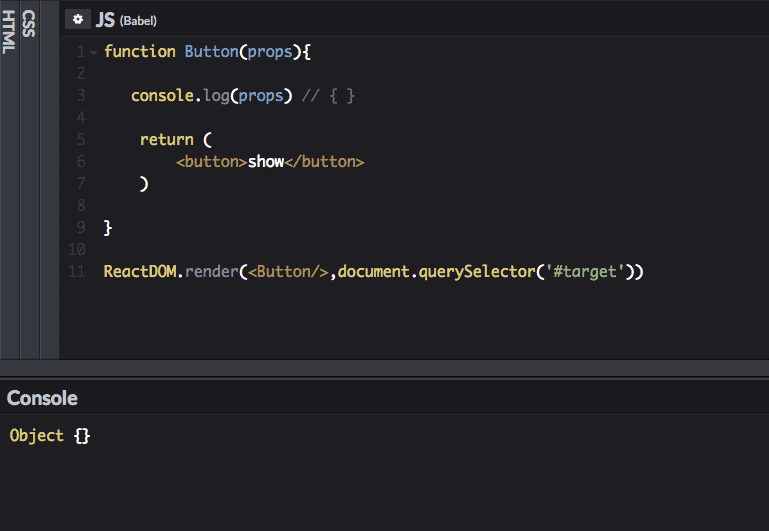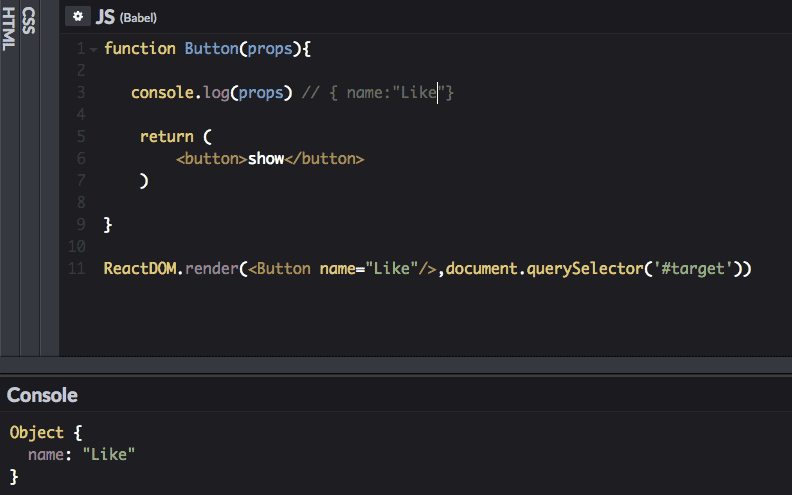A beginners guide to react props
In this tutorial, we will learn about how to pass the data to the components by using props.
Props
- Props are used to pass the data from parent to child components.
- Props are readonly.
Let’s see in practice.
Functional components
Functional components in the react accepts the props object as a parameter. Let’s log the props parameter inside the below component.
function Button(props){
console.log(props) // { }
return (
<button>show</button>
)
}
ReactDOM.render(<Button/>,document.querySelector('#target'))
Have you seen in the above image an empty Object is logged inside the console?
If we pass data as an attribute to the components, that data is available inside the components as a props object.
function Button(props){
console.log(props) // {name:"Like" }
return (
<button>show</button>
)
}
ReactDOM.render(<Button name="Like" />,document.querySelector('#target'))
In the above code, we passed name attribute to the Button component so that we can access that data inside the Component by using props object.
Now let’s remove the name of the button and replace with the props.name so that we can have more control over the Button component.
function Button(props){
return ( <button>{props.name}</button>
)
}
function App() {
return (
<div> <Button name="Like" /> <Button name="Share" /> <Button name="Comment" />
</div>
)
}
Props in class-based components
In class based components, we need to use this.props to access the props data.
class User extends React. Component{
render(){
<div>
<h1>{this.props.name}</h1>
<ul>
<li>{this.props.id}</li>
<li>{this.props.age}</li>
</ul>
</div>
}
}
class App extends React. Component{
render(){ <User name="nick" age=34 id = 11112 />
}
}
Let’s replace the above User component data using curly braces.
class App extends React.Component{
render(){
<User name={"nick"} age={3} id = {11112} /> }
}
props are not only limited to the strings or numbers we can also pass functions, objects or components.
Passing objects using props
class Date extends React.Component{
render(){
const {day,month,year } = this.props.data
return (
<ul>
<li>{day}</li>
<li>{month}</li>
<li>{year}</li>
</ul>
)
}
}
class App extends React. Component{
render(){
return(
<Date data = {{day:11,month:"December",year:2018 }} /> )
}
}In the above code we passed an object as a prop to the Date Component so that inside the Date component we can access that data using this.props.data.
Passing components as a prop
function Button(props) {
return (<button>{props.name}</button>)
}
function Post(props) {
return (
<div>
<h1>{props.title}</h1>
<p>{props.body}</p>
<div>
{props.share}
{props.like}
</div>
</div>
)
}
class App extends React. Component {
render() {
return (
<div>
<Post title={"My first post"} body={"some body text"}
share={ <Button name="Share"/> } like={ <Button name="Like"/> } />
</div>
)
}
}Passing functions as a props
function Button(props) {
return (
<div>
<button>{props.name}</button>
{props.icon("https://cdn3.iconfinder.com/data/icons/glypho-free/64/share-512.png")} </div>
)
}
class App extends React.Component {
render() {
return (
<div>
<Button name="share" icon={function (icon) { return <img src={icon} width="16px" /> }} /> </div>
)
}
}In the above code we passed a function as a prop to the Button Component so that we invoked this function by passing an icon as its argument inside the Button component.
Passing functions as a props is called render props technique.






